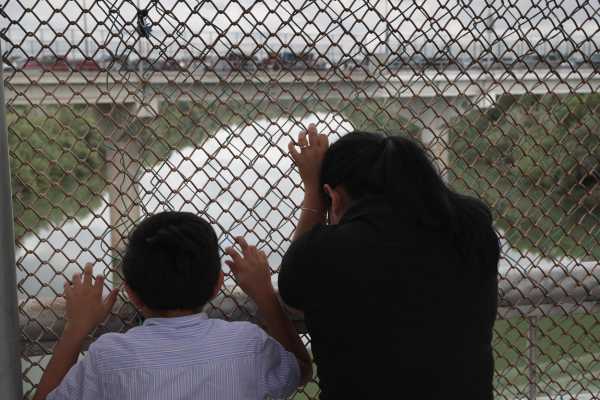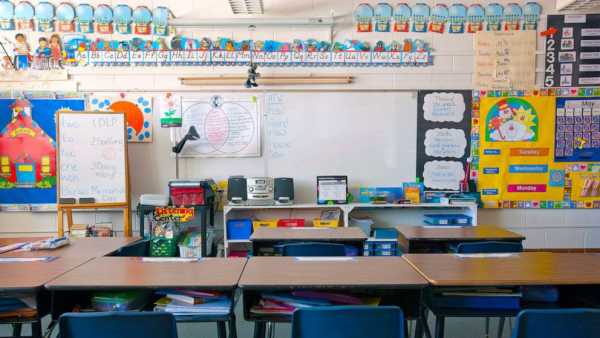
Everything about the Trump administration’s plan to radically restrict asylum for people crossing from the US into Mexico without papers — banning adults and families who cross between ports of entry (official border crossings) from entering the asylum process — has moved quickly.
The policy itself has been developed in the last few weeks, as a slow-moving crisis of resources on the US-Mexico border turned into a hot political issue thanks to President Donald Trump’s obsession with the migrant “caravan.”
It became public on Thursday evening and Friday morning, less than a day before it was set to go into effect. (Even as of late Friday, some asylum officers hadn’t received guidance about how to implement the new policy.)
And by mid-afternoon on Friday, the policy had already been challenged in court by the ACLU and other immigration advocates who hope the Northern District of California can put the policy on hold before it even goes into effect at midnight Friday night.
It’s moved so quickly — during a time when there’s lots of other news dominating the headlines — that it hasn’t attracted the attention of other Trump signature policies on immigration. But it is every bit as significant.
Hundreds of people a day cross into the US between ports of entry and seek asylum. Any who arrive at the border while this policy is in effect — it’s scheduled to last 90 days but could be extended or renewed later — will be forced to choose between having to wait for weeks or longer at overloaded ports of entry and risking near-immediate deportation by crossing illegally and turning themselves in to Border Patrol. Illegal crossing between ports of entry could give them a chance at staying in the US, but that chance will be much more remote, and with many fewer privileges, than asylum seekers currently get.
It’s a continued escalation of the Trump administration’s months-long war against the asylum system on the southern border. But it’s far more legally dicey than anything the administration has done so far — even the travel ban.
Whether or not the policy goes into effect Friday night, the fight over it is going to continue. As long as people continue to seek asylum in the US in large numbers, the Trump administration will be trying to stop them — and as long as the administration tries to stop them, there will be human rights concerns about whether the US is upholding its obligations to protect fleeing people from harm.
1) What did the Trump administration do?
Under US law, people who enter the US without papers are legally able to apply for asylum. If they show that they’re at risk of persecution in their home country (due to their race, nationality, religion, political opinion or membership in a particular social group) the US is supposed to give it to them.
Unless, that is, they are subject to specific restrictions. The Trump administration used a two-part strategy to carve out such a restriction.
On Thursday, the Trump administration posted the text of a regulation (which was formally published in the Federal Register on Friday) that added a restriction for people who were subject to a presidential entry ban, like the “travel bans” Trump signed in 2017. It also set out a process for how the asylum process would change for someone subject to such a ban.
The regulation went into effect immediately, skipping the traditional months-long regulatory process. Then, on Friday morning, Trump signed an entry ban on people entering the US from Mexico between ports of entry.
The combined effect of the two parts is that someone who crosses the US-Mexico border between ports of entry — i.e., who commits the misdemeanor of improper entry — between midnight Friday night and midnight on February 8, 2019, will not be eligible for asylum. Instead, they’ll be subject to an alternative process set up by the regulation, modeled off the process for asylum-seekers who have been convicted of serious crimes in the US.
2) How did someone who enters the US without papers get asylum before this policy went into effect?
Someone who enters the US without papers — either at a port of entry or otherwise — is subject to immediate deportation without a court hearing, unless she says she wants to claim asylum or that she fears persecution in her home country. In those cases, she’s entitled to an interview with an asylum officer.
Generally, if the asylum officer determines that she has a “credible fear” of persecution (in other words, that there’s a significant possibility she’d be persecuted if deported based on her race, nationality, religion, political opinion, or membership in a particular social group), she is allowed to go before an immigration judge in the same court process that unauthorized immigrants arrested while living in the US are entitled to. There, she’s able to make her case for asylum. And in the meantime, since immigration court hearings take months or years, she’s legally able to work and live in the US.
Even if she is being persecuted, she might still be ineligible for asylum, if she has a certain criminal record in the US or her home country, for example. But the judge will wait until the end of the process to make that judgment. If she is ineligible for asylum but still has reason to fear persecution, she can receive a lesser form of protection — called withholding of removal — that allows her to stay in the US but gives her no path to permanent legal status.
3) How will the process work under the new Trump policy?
Someone who enters the US from Mexico without papers between ports of entry will still be entitled to an interview with an asylum officer. But the asylum officer is required to screen not for a credible fear of persecution, but a “reasonable” fear — a higher standard that requires not just a significant possibility of persecution but a determination that persecution is more likely than not.
The “reasonable fear” standard is used only in rare cases under the status quo — for immigrants who’ve already been ordered deported and returned to the US, and immigrants who have committed serious crimes. But the difference in pass rates is striking. In credible fear interviews, about 75 percent of all asylum seekers pass. In reasonable fear interviews, a little more than 25 percent do. Even assuming that many asylum seekers who are currently subject to the credible fear standard would also pass the more stringent one, that’s still thousands of immigrants a month who would end up failing their screening interviews and being summarily deported.
People who don’t pass the reasonable fear screening will be deported summarily (unless they choose to have a judge review the finding). People who do pass the reasonable fear screening will be allowed to go before an immigration judge. Even then, though, they still wouldn’t be eligible for asylum. Their only options would be withholding of removal and protection under the Convention Against Torture.
That allows the US to fulfill its obligations under international law — which prevents countries from returning migrants to places where their lives are in danger — but doesn’t give people any access to permanent legal status.
And it doesn’t allow families to go through the system together; while a mother can get asylum for her child when her own case gets approved, mother and child each individually have to prove they’re eligible for other protections. (This Vox article offers more detail as to the difference between asylum and the lesser forms of protection.)
4) What’s the problem they’re trying to solve?
Asylum seekers are making up an ever-larger share of people crossing into the US from Mexico. And the Trump administration is convinced that most of them are trying to game the system.
While way fewer people have been entering the US without papers over the past few years than have in the past, the people who are coming in now aren’t the same type of migrants the US saw in the decades of highest unauthorized migration. They’re more likely to be from Central America (specifically, Guatemala, Honduras, and El Salvador) than Mexico. They’re more likely to be families or children than single adults. And most importantly, they’re increasingly likely to say they fear deportation in their home country — and pass their credible-fear screenings.
But even though the number of people making it into the US (at least temporarily) by passing their credible fear screenings keeps rising, the number of people who ultimately get asylum in those cases hasn’t risen to meet it at all. Essentially, the trend of the past several years has been a growth in the number of people who start the asylum process but miss the cut, or simply disappear, along the way.
This drop-off happens at every stage of the process. Less than 40 percent of people who pass the initial screening interview for asylum submit a written asylum application, for example, which is a necessary step in the process even though they’ve passed the interview and gotten assigned a court hearing.
Families seeking asylum, in particular, appear to have trouble showing up to their court hearings, which means they get ordered deported in absentia. In fact, the biggest determinant of whether a family gets a deportation order appears to be whether they show up in court.
There are lots of reasons why families could be missing their court dates. A 2018 study by Catholic Legal Immigration Network and the Asylum Seekers Advocacy Project, for example, offered suggestive evidence that families were trying to keep track of their court dates, but bureaucratic and structural issues — from inattentive lawyers to trouble getting the hearing moved to the correct location — got in the way.
The Trump administration, however, sees the drop-off rate as proof that people are using the credible fear screening to sneak into the country on the basis of asylum claims that are either fraudulent or don’t show persecution that meets the legal standards for asylum.
The administration is convinced asylum seekers aren’t just getting lost in the system — they’re deliberately disappearing because they know that if they continued to pursue asylum, their claims wouldn’t get approved. Trump has accused smugglers of coaching asylum seekers to say the “magic words” that will allow them into the country. A senior administration official described the asylum system to press last month as “the biggest loophole in the world,” and said it was beset by “systemic fraud” — pointing to the low approval rate as evidence that most asylum claims weren’t just insufficient, but malicious.
5) Why is this happening now?
It’s hard to imagine that this policy would have been pushed through if Trump and his administration hadn’t spent the few weeks before the midterm election freaking out about the caravan of several thousand asylum seekers moving slowly through Honduras, Guatemala, and southern Mexico.
To be fair, the administration has been worried about the rising number of border-crossers for over a year. It attempted to address this with a spring crackdown that culminated in widespread family separation of border crossers — but crossings didn’t drop while family separation was in effect, and they rose precipitously afterward. (The Trump administration believes that ending the family separation policy encouraged families to come, though it’s hard to prove this.) But the caravan caught Trump’s attention and sent the administration into crisis mode.
As the Trump administration unveiled the new policy, though, leaders of the caravan announced they were setting off from Mexico City for Tijuana — and from there, presenting themselves for asylum at the San Ysidro port of entry. In other words, unless some members peel off, the caravan won’t even be subject to the new policy because they won’t be crossing between ports of entry.
Instead, the Trump administration argues this policy is needed immediately because the US system is simply overwhelmed. And that’s clearly true. The disagreement is over whose fault it is.
The US has developed a border policy that’s designed to maximize the efficient apprehension and deportation of everyone trying to cross the border illegally and not get caught. It is not designed to facilitate the processing of people for asylum — especially families.
Ports of entry are already overwhelmed with asylum seekers; at most ports, asylum seekers have to wait on the Mexican side of the border, sometimes for weeks, before Customs and Border Protection officials allow them to cross into the US and claim their right to asylum. Border Patrol facilities (for people apprehended between ports of entry) are also running out of capacity to take asylum-seekers in.
Much of the “refugee corps” — the US Citizenship and Immigration Services officers who are responsible for interviewing refugees around the world who are applying to resettle in the US — has been detailed to do asylum interviews of detained border-crossers. And Immigration and Customs Enforcement claims it’s so overwhelmed with families coming into the US that it has to simply release them at bus stations, instead of working with nonprofit organizations to help orient families and get them where they need to be to continue their asylum case.
Some administration officials blame asylum seekers for this, saying they’re deliberately trying to sabotage the system. Others blame Congress for not giving DHS the money it needs. Immigration advocates blame the administration — saying they’re either unwilling to devote the needed resources to process asylum-seekers faster, especially at ports of entry, or that they are actively trying to block people from their legal right to asylum.
6) Will this work?
It’s hard to answer this because it’s hard to say what, exactly, the Trump administration expects this plan to achieve — if it’s allowed to go into effect, which is a big if.
The US wants to be able to refuse all asylum seekers who come through Mexico — but Mexico won’t agree within 90 days. The explicit goal of the 90-day ban — the thing that would cause Trump to lift it even before the 90 days were up — would be getting Mexico to sign a safe-third-country agreement with the US. That would allow the US to turn back all asylum seekers who had traveled through Mexico. (The US currently has such an agreement with Canada.)
A safe-third-country agreement would essentially make the current Central American migration, which has brought hundreds of thousands of people from Guatemala, Honduras, and El Salvador to the US and Mexico to seek asylum in the last several years, Mexico’s problem alone to solve. Mexico, whose new president will arrive in office on December 1, has shown no interest so far in signing such an agreement.
The Trump administration says it’s trying to encourage people to go to ports of entry — but those are already backed up. One senior administration official told press Tuesday that “what we are trying to do is funnel asylum claims through the ports of entry, where we are better resourced, have better capabilities, and have better manpower and staffing.”
That is really not true. Ports of entry have been overwhelmed with asylum-seekers even before Border Patrol units between ports of entry were. It’s hard to imagine how ports of entry can accommodate more asylum seekers if they can’t accommodate the ones coming now — and they’re not staffing up at ports of entry in anticipation of the new plan going into effect.
The Trump administration will probably be able to deport more people more quickly — but it’s really not clear how many more. In theory, raising a credible-fear standard 75 percent of asylum seekers pass to a reasonable-fear standard only 25 percent of asylum seekers pass would mean that thousands of people a month fail their screenings — and become eligible for summary deportation. But maybe the reasonable-fear passage rate is only low because the people who are subject to that standard now have less compelling cases than people fleeing gang violence and government indifference in Honduras.
How this shakes out will depend a lot on how it’s implemented, even down to the level of individual asylum officers. It’s possible that pretty much everyone who would have been allowed to stay in the US and seek asylum before this policy will still be able to stay in the US (and seek lesser protections) afterward. It’s not likely, though. Some people will fall through the cracks between the old standard and the new one; it’s just a question of how many.
7) Is this legal?
There’s a reason that the first lawsuit against the policy was filed less than 6 hours after the proclamation was signed. Even for the Trump administration, this policy is a bold assertion of executive power to restrict immigration to the United States.
While the underpinnings of the right to asylum are a matter of international law, that isn’t the Trump administration’s biggest legal obstacle. By allowing people to stay in the US under withholding of removal or protections under the Convention Against Torture, the US covers its legal obligation not to return people to countries where their lives would be in danger.
The problem is US law.
The text of the Immigration and Nationality Act specifies that people may apply for asylum “whether or not” they enter the US at a port of entry. The Trump administration is setting up to render that “or not” basically dead letter — at least as long as the proclamation is in effect.
The administration justifies this by saying that the law also gives the attorney general broad power to set restrictions on asylum, and the president broad power to suspend entry (an interpretation encouraged by the Supreme Court’s ruling in the travel ban case in June, which didn’t actually specify any limits on this power).
The ACLU, and the other legal advocates and immigration service providers who’ve sued over the policy, disagree. They argue that this isn’t just use of discretion to fill in a gap Congress didn’t address, but overriding a specific thing Congress wrote into the law — which the administration can’t do.
Furthermore, they argue that the way the policy was rolled out — by issuing a regulation that immediately went into effect — is a violation of the Administrative Procedure Act. There’s a high bar to skip the regulatory review process. The ACLU argues the administration didn’t clear it.
A federal judge is going to agree with the ACLU and rule against the administration — that is nearly certain. (The ACLU filed in the Northern District of California, which isn’t friendly turf for Trump.) The only question is whether this happens before midnight, or afterward.
Of course, the Trump administration will appeal any ruling against it. The case may end up at the Supreme Court within a matter of days, or it might take several months — or longer — but it’s almost certain to end up there, just like every other legal fight on immigration Trump has picked.
According to Julia Ainsley of NBC, the administration thinks it’s going to prevail with the newly ensconced conservative majority on the Supreme Court. It might be right (though the administration might not be able to count on some of the court’s conservatives to back the executive branch over Congress).
Politically, a ruling against the administration could give both sides what they want — Trump and company could rail against liberal judges, and the ACLU could claim another victory against Trump.
But whether or not this policy goes into effect, it’s not going to soothe the Trump administration’s concerns with people coming into the US without papers. It’s not going to resolve the resource crisis at the border. To the extent that the Trump administration is committed to reducing the number of people claiming asylum in the US by any means necessary, this is just one front in a multi-front battle.
Sourse: vox.com






